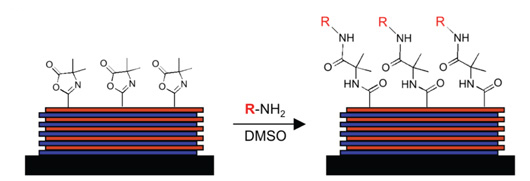Materials & Chemicals

Layer-by-Layer Covalent Assembly of Reactive Ultrathin Films
WARF: P08130US
Inventors: David Lynn, Maren Buck, Jingtao Zhang
The Wisconsin Alumni Research Foundation (WARF) is seeking commercial partners interested in developing covalently cross-linked reactive thin films fabricated using azlactone functionalized polymers.
Overview
Methods that allow reactive polymer films to be deposited or assembled on topologically complex substrates are useful for the patterning or chemical modification of surfaces in a broad range of applications. Aqueous methods for the layer-by-layer deposition of oppositely charged polyelectrolytes are used widely for the assembly of thin polymer films. These methods generally take advantage of weak interactions between the polyelectrolytes and the oppositely charged surfaces, and the stability of the resulting thin films depends on the nature of these weak interactions and the extent to which they can be disrupted by changes in environmental conditions. The stability of thin polymer films could be enhanced by chemically cross-linking the polyelectrolyte components after fabrication.
The Invention
UW–Madison researchers have developed robust methods for the layer-by-layer fabrication of covalently cross-linked ultrathin films. This approach makes use of fast and efficient “click”-type interfacial reactions between poly(2-alkenyl azlactone)s and appropriately functionalized polyamines. In contrast to conventional, aqueous methods for the layer-by-layer fabrication of thin films, fabrication of these ultrathin films occurs in organic solvents and is driven by rapid formation of covalent bonds during assembly. This approach also yields films with residual azlactone groups that can be used to tailor the surface properties of the films by treatment with a broad range of chemical and biological functionalities.
Applications
- Non-wetting surfaces for use in self-cleaning applications, non-fouling surfaces and membranes for separations
- Coatings for instruments, including medical devices and disposable research tools such as pipette tips, tubes or petri dishes
- Surfaces that prevent or promote adhesion of cells or proteins
- Other applications may include tissue engineering or catalysis
Key Benefits
- Enables precise, nanometer-scale control over thicknesses and compositions of covalently cross-linked thin films
- Reactivity of these cross-linked films allows them to be further functionalized with chemical and biological compounds to modify or pattern film properties.
- Ultrathin films can be freestanding or surface-attached.
- Films may be hydrophilic, hydrophobic or a mixture of both.
- Suitable for organic and inorganic surfaces with complex topographies
Publications
- Buck M.E. and Lynn D.M. 2010. Free-Standing and Reactive Thin Films Fabricated by Covalent Layer-by-Layer Assembly and Subsequent Lift-Off of Azlactone-Containing Polymer Multilayers. Langmuir. 26, 16134-16140.
- Buck M.E. and Lynn D.M. 2010. Functionalization of Fibers Using Azlactone-Containing Polymers: Layer-by-Layer Fabrication of Reactive Thin Films on the Surfaces of Hair and Cellulose-Based Materials. ACS Appl. Mater. Interfaces 2, 1421-1429.
- Buck M.E, Zhang J. and Lynn D.M. 2007. Layer-by-Layer Assembly of Reactive Ultrathin Films Mediated by ‘Click’-Type Reactions of Poly(2-Alkenyl Azlactone)s. Adv. Mater. 19, 3951-3955.
- Buck et al. 2009. Chemical Modification of Reactive Multilayered Films Fabricated from Poly(2-Alkenyl Azlactone)s: Design of Surfaces that Prevent or Promote Mammalian Cell Adhesion and Bacterial Biofilm Growth. Biomacromolecules 10, 1564-1574.
- Buck M.E. and Lynn D.M. 2010. Reactive Layer-by-Layer Assembly of Suspended Thin Films and Semi-Permeable Membranes at Interfaces Created Between Aqueous and Organic Phases. Adv. Mater. 22, 994-998.
- Kinsinger M.I., Buck M.E., Abbott N.L. and Lynn D.M. 2010. Immobilization of Polymer-Decorated Liquid Crystal Droplets on Chemically Tailored Surfaces. Langmuir 26, 10234-10242.
- Saurer et al. 2011. Fabrication of Covalently Crosslinked and Amine-Reactive Microcapsules by Reactive Layer-by-Layer Assembly of Azlactone-Containing Polymer Multilayers on Sacrificial Microparticle Templates. J. Mater. Chem. 21, 1736-1745.
- Buck M.E., Schwartz S.C. and Lynn D.M. 2010. Superhydrophobic Thin Films Fabricated by Reactive Layer-by-Layer Assembly of Azlactone-Functionalized Polymers. Chem. Mater. 22, 6319-6327.
- Buck M.E. and Lynn D.M. 2011. Layer-by-Layer Fabrication of Covalently Crosslinked and Reactive Polymer Multilayers Using Azlactone-Functionalized Copolymers: A Platform for the Design of Functional Biointerfaces. Adv. Eng. Mater. 13, B343-B352.
Tech Fields
For current licensing status, please contact Michael Carey at [javascript protected email address] or 608-960-9867
Figures

